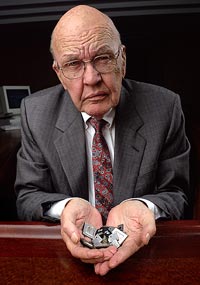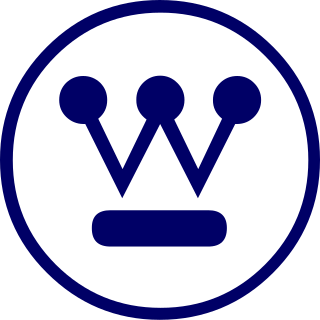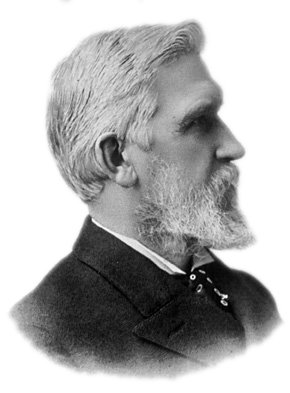
Jack St. Clair Kilby was an American electrical engineer who took part in the realization of the first integrated circuit while working at Texas Instruments (TI) in 1958. He was awarded the Nobel Prize in Physics on December 10, 2000.

The Westinghouse Electric Corporation was an American manufacturing company founded in 1886 by George Westinghouse. It was originally named "Westinghouse Electric & Manufacturing Company" and was renamed "Westinghouse Electric Corporation" in 1945. The company acquired the CBS television network in 1995 and was renamed "CBS Corporation" until being acquired by Viacom in 1999, a merger completed in April 2000. The CBS Corporation name was later reused for one of the two companies resulting from the split of Viacom in 2005.
The Huntington Library, Art Museum and Botanical Gardens, known as The Huntington, is a collections-based educational and research institution established by Henry E. Huntington and Arabella Huntington in San Marino, California. In addition to the library, the institution houses an extensive art collection with a focus on 18th and 19th century European art and 17th to mid-20th century American art. The property also has approximately 120 acres (49 ha) of specialized botanical landscaped gardens, including the "Japanese Garden", the "Desert Garden", and the "Chinese Garden".

Theodore Harold Maiman was an American engineer and physicist who is widely credited with the invention of the laser. Maiman's laser led to the subsequent development of many other types of lasers. The laser was successfully fired on May 16, 1960. In a July 7, 1960, press conference in Manhattan, Maiman and his employer, Hughes Aircraft Company, announced the laser to the world. Maiman was granted a patent for his invention, and he received many awards and honors for his work. His experiences in developing the first laser and subsequent related events are recounted in his book, The Laser Odyssey, later being republished in 2018 under a new title, The Laser Inventor: Memoirs of Theodore H. Maiman.

Elisha Gray was an American electrical engineer who co-founded the Western Electric Manufacturing Company. Gray is best known for his development of a telephone prototype in 1876 in Highland Park, Illinois. Some recent authors have argued that Gray should be considered the true inventor of the telephone because Alexander Graham Bell allegedly stole the idea of the liquid transmitter from him. Although Gray had been using liquid transmitters in his telephone experiments for more than two years previously, Bell's telephone patent was upheld in numerous court decisions.

Simon "Si" Ramo was an American engineer, businessman, and author. He led development of microwave and missile technology and is sometimes known as the father of the intercontinental ballistic missile (ICBM). He also developed General Electric's electron microscope. He played prominent roles in the formation of two Fortune 500 companies, Ramo-Wooldridge and Bunker Ramo Corporation.

Joseph Frederick Engelberger was an American physicist, engineer and entrepreneur. Licensing the original patent awarded to inventor George Devol, Engelberger developed the first industrial robot in the United States, the Unimate, in the 1950s. Later, he worked as entrepreneur and vocal advocate of robotic technology beyond the manufacturing plant in a variety of fields, including service industries, health care, and space exploration.

Berg connector is a brand of electrical connector used in computer hardware. Berg connectors are manufactured by Berg Electronics Corporation of St. Louis, Missouri, now part of Amphenol.

NEMA connectors are power plugs and receptacles used for AC mains electricity in North America and other countries that use the standards set by the US National Electrical Manufacturers Association. NEMA wiring devices are made in current ratings from 15 to 60 amperes (A), with voltage ratings from 125 to 600 volts (V). Different combinations of contact blade widths, shapes, orientations, and dimensions create non-interchangeable connectors that are unique for each combination of voltage, electric current carrying capacity, and grounding system.
The Burndy Library was one of the world's largest collections of books on the history of science and technology. It was disestablished in 2006 and its collections transferred to the Huntington Library.

Bern Dibner was an electrical engineer, industrialist, and historian of science and technology. He originated two major US library collections in the history of science and technology.
Larry F. Weber, is an American electrical engineer and businessman.

Telecommunications engineering is a subfield of electronics engineering which seeks to design and devise systems of communication at a distance. The work ranges from basic circuit design to strategic mass developments. A telecommunication engineer is responsible for designing and overseeing the installation of telecommunications equipment and facilities, such as complex electronic switching systems, and other plain old telephone service facilities, optical fiber cabling, IP networks, and microwave transmission systems. Telecommunications engineering also overlaps with broadcast engineering.
The Bryant Electric Company was a manufacturer of wiring devices, electrical components, and switches founded in 1888 in Bridgeport, Connecticut. It grew to become for a time both the world's largest plant devoted to the manufacture of wiring devices and Bridgeport's largest employer and was involved in a number of notable strikes, before being closed in 1988 and having its remaining interests sold to Hubbell in 1991.

The Secretary of Defense Employer Support Freedom Award is the highest recognition given by the U.S. Government to employers for their support of their employees who serve in the National Guard and Reserve. To be eligible for the award, an employer must be nominated by one of its Guard or Reserve employees, or a family member of that employee.
The Dibner Institute for the History of Science and Technology (1992–2006) was a research institute established at MIT, and housed in a renovated building (E56) on campus at 38 Memorial Drive, overlooking the Charles River.

Octavio M. "Tav" Salati was an American engineer, academic and educator. He served as Professor of Electrical Engineering at the University of Pennsylvania in the field of Electromagnetic Compatibility.
Carlos Katz is an American electrical engineer, researcher and the recipient of the 2010 IEEE award. His area of research is the properties and methods of manufacture of extruded and laminar dielectric high voltage power cables, and extension of service life of installed cables. He has written papers about the effects of water treeing on the life of cable installations.

Hubbell Incorporated, headquartered in Shelton, Connecticut, is an American company that designs, manufactures, and sells electrical and electronic products for non-residential and residential construction, industrial, and utility applications. Hubbell was founded by Harvey Hubbell as a proprietorship in 1888, and was incorporated in Connecticut in 1905.

Kshitish Ranjan Chakravorty was an Indian engineer, fertilizer scientist and the head of the Planning and Development Division of the Fertilizer Corporation of India (FCI). He was credited with the establishment of Planning and Development Division of FCI and with the development indigenous fertilizer plants in India. Born on 1 February 1916, Chakravorty was the author of two books, Science Based on Symmetry, Volume 1 and Energy Field of the Universe and Atom, Part 1 and he held the patent for a process on an ionexchange material from the acid sludge. He sat in the Committee on Tachnical Consultancy Services of the Government of India and was an Indian member of the Indo-US Workshop on the Management of Organization of Industrial Research held in 1970. He received the fourth highest Indian civilian award of the Padma Shri in 1954, making him one of the first recipients of the award. The Council of Scientific and Industrial Research, the apex agency of the Government of India for scientific research, awarded him the Shanti Swarup Bhatnagar Prize for Science and Technology, one of the highest Indian science awards for his contributions to Engineering Sciences in 1968.















